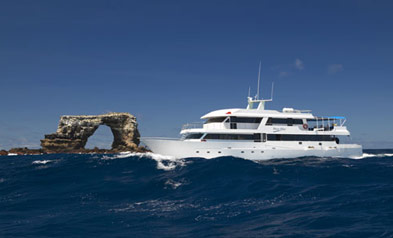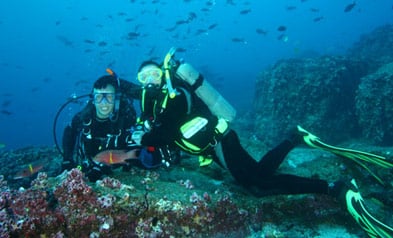Galapagos Diving FAQs
Find all the answers for your Galapagos tour:

Types of Diving Tours:
Q: What tour options do I have for diving in Galapagos?
A: There are 3 tour options for diving tours, which you can choose from or combine based on your preferences. There is a liveaboard diving cruise, which will allow you to venture to farther and more remote islands. There is also a hotel-based option where you stay in one hotel on one island for your diving tour, and island-hopping where you will stay on multiple islands in different hotels.
Q: How do diving cruises operate?
A: Cruise diving tours are perfect for travelers who want to explore more the remote areas of Galapagos as you’ll be spending your time traveling between islands while asleep in your cabin at night. On these tours, there is also a great combination of water activities like snorkeling and kayaking, and land activities such as hiking.
Q: How do island-hopping diving tours work?
A: Island-hopping tours are great for anyone who prefers to sleep on land and have free time to explore many local towns in the evening and nighttime. You will have more opportunities with an island hopping tour to explore the highlands of each island you stay on as well as more flexibility with your activities.
Q: How do hotel-based diving tours work?
A: A hotel-based tour is great for those who really want to explore every inch of one island, have more time at each visitor site, and sleep on land. When you stay in one hotel you will spend less time in transit between Islands and really get familiar with the culture of the town you stay in.

Cruise Features & Accommodation:
Q: What are the safety standards for diving tours?
A: All liveaboard boat tours use top navigational equipment, safety aides, and safety equipment, including: VHF and HI-SUB radios, GMDSS, Furuno GPS, Depthsounder with alarm, EPIRB, defibrillator, Oxygen system, and first aid kits. All of the required safety equipment and drills are carried out.
Q: What about meals?
A: All meals are included on live aboard tours. The Galapagos Sky and the Aggressor III include national brand alcoholic beverages, while other live aboard tours do not include alcohol. Each ship offers a range of national and international cuisine to satisfy the weary diver! For day-trip diving, snacks, water, and soda or juice, as well as a meal are included during the day.
Q: What gear do diving boats usually have?
A: Most diving cruises have the following gear available for rent: BCD, Reg-set, wetsuit, mask, snorkel, fins, computer, and gloves.
Q: How long do diving cruises take?
A: Diving cruises are normally 8-days.
Q: Why aren't there shorter diving cruises?
A: There are no diving cruises that run short itineraries because Wolf and Darwin Islands are the most famous islands for diving, and they are located far away from the main group of islands. It's an all night voyage to get there and since these are the premiere diving sites, boats will stay there for a couple of nights.
Q: What type of guides do diving cruises have?
A: Most boats include at least two Galapagos National Park certified dive guides.

Galapagos Underwater:
Q: What are the best dive sites in Galapagos?
A: For Live aboard tours: Darwin and Wolf Islands. Here, you'll have the best chance to see whale sharks and large schools of hammerheads. For Land-based tours: Gordon Rocks to see hammerhead sharks and North Seymour to see white-tip reef sharks.
Q: What are the diving conditions like?
A: Galapagos diving conditions can be challenging. Currents are moderate to strong and may require you to grab hold of rocks below the surface so you don't drift away. Surges may create difficulties during your safety stops. The average visibility is 10 - 21m (30 - 70ft), but can be less.
Divers must follow their Dive Master and Galapagos Marine Reserve rules at all times. Divers must stick with the group and their Dive Master at all times, remain with their buddies, and ascend in pairs. Safety Stops are obligatory for all Galapagos dives.
Q: When is the best time to go diving?
A: June to December. However, September November is the best time to see the most wildlife, but the waters will be colder. The water for diving is cold all year-round, but even COLDER during this time of year, with thermoclines as well. Wetsuits of 7mm will be needed, as well as a hood and gloves.
Q: What is the weather like in Galapagos?
A: There are two seasons in the Galapagos Islands: June to December, the islands experience their cooler, dryer “garua” season. January to May is the warmer season.

Traveling to Galapagos:
Q: How do I get to the Galapagos Islands?
Q: How much luggage is allowed on the flight to Galapagos?
A: Regarding luggage, no more than one 23 kg checked bag per person, and one additional regular size carry-on bag of 8 kg is allowed.
Q: How long is the flight from Quito to Galapagos?
A: Flying from Quito to Galapagos takes around two and a half hours. Most of these flights make a 30 minute stop in Guayaquil, but you won’t have to exit the plane.
Q: Arrival / Departure
A:Arrivals and departures in Galapagos can take place in one of two airports: San Cristobal Island, or on Baltra Island (the airport used for Santa Cruz Island). When leaving Quito or Guayaquil, all passengers are charged a $20 US Transit Control Card, and upon arrival to the Galapagos Islands, a $100 (subject to change) US National Park Entrance Fee is charged to all international passengers. Click here to learn more about these entrance fees.
Q: What should I bring?
A: Besides an underwater camera or video camera to capture all the magic, we recommend bringing necessary items for land visits, such as a good sun hat, sunscreen, and eye protection. The sun here is extremely strong. Be sure to bring your diving license and insurance information as well. Click here for a packing list for a Galapagos tour.
Q: What equipment should I pack?
A: Divers are encouraged to bring their own equipment to the Galapagos Islands. Your dive watch and other diving gadgets are key, as well as a valve adapter for DIN valves. Some equipment can be rented, but be sure to book ahead to get the right size. You do not need to bring weights or weight belts, unless you prefer a weight-integrated belt. Click here to view a general packing list for a Galapagos trip.
Q: What is the Currency in Ecuador?
A: Ecuador uses US currency.

Requirements:
Q: How much experience is required for diving?
A: Galapagos dive sites can be challenging due to currents and surges. Only experienced divers should be going on liveaboard boat tours.
Q: Do I need insurance?
A: Yes. Diving insurance is mandatory for the Galapagos Islands. Do not confuse regular medical insurance with diving specific insurance, like DAN (Divers Alert Network). There is a Hyperbaric Chamber in Puerto Ayora, and all live aboard tours charge an extra $35 fee to help keep this important service and its staff operational in the islands. Click here for a complete list of Galapagos travel requirements and regulations.
Q: Is there a minimum or maximum age restriction?
A: Under certain circumstances, which depend on your dive application, health certifications may be required. Children 10 and older are allowed only if they are certified divers. If non-divers, children must be 16 years of age or older.

